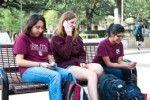It was game day at Kyle Field. The crowd of 80,000 strong watched and screamed in celebration as Johnny Football broke another school record. After the mug-downs and high fives, Aggies pulled out their smartphones to share the news with the world, only to be shut down by a lack of cell reception and dropped calls.
Sports stadiums have always posed a challenge to telecommunications operators such as AT&T and Verizon. The concrete structures and the building architecture of such sports arenas have a tendency to reflect away cellphone radiation. Kyle Field is no exception. With the evolution seen in telecommunications traffic, sports stadiums have begun to garner increased attention from telecommunications operators.
The lack of cellphone service on game days has been inconvenient, said Rebecca Ratliff, sophomore psychology major. I have had situations when I needed to get ahold of someone for the game and was unable to. There are, however, random spots with service that can be found so it is not completely hopeless when it comes
to communication.
Cellphone reception at Kyle Field has come a long way from the mere two cell sites, five years ago, to 45 cell sites. A cell site is a location where telecommunications equipment such as antennas and signal amplifiers are placed to provide wireless-network coverage in a particular area.
In September of 2011, AT&T upgraded the telecommunications infrastructure at Kyle Field with the installation of a new Distributed Antenna System. This DAS installation consists of 185 strategically-located antennas that provide wireless-network coverage all over the stadium.
We take cellular coverage on campus very seriously, said Walt Magnussen, director of University Telecommunications at A&M. TAMU, working with the leading wireless providers AT&T and Verizon, was one of the first universities in the U.S. to install a fiber-optic based, distributed antenna. Since the initial installation we have increased infrastructure every year. Because of this capability, College Station was one of the first areas in the state to have 4G coverage, even ahead of Austin. In spite of this, we are still having coverage issues, but they are generally limited to large events.
Football games are a major event for University Telecommunications as well as the campus telecommunications operators, AT&T and Verizon. Personnel from University Telecommunications including the Director and AT&T and Verizon do a signal-strength evaluation at various spots on and around Kyle Field, when the game is in progress.
AT&T network engineers are on site for every A&M home football game constantly looking for new ways to enhance our customers network experience whether thats making a call, checking e-mail, downloading apps or surfing the Internet, said Carlos Ramirez, representative for AT&T. This helps to identify weak signal problem areas and test network performance while the game is in progress.
The network operations department of AT&T and Verizon of Houston and Dallas monitor network performance while the game is in progress. Dynamic optimization techniques are adopted, such as reducing interfering traffic from cell sites adjacent to Kyle Field.
The wireless traffic at football games somehow manages to stay one step ahead of our ability to build, Magnussen said. Since our DAS was one of the first and most successful in the United States, we have a constant barrage of other universities looking at us to see how it is done.
The telecommunications industry is able to serve the existing demand for network resources because at no point in time will all the people in an area pick up their cellphones simultaneously and make calls. Events such as football games are a challenge for the network as they counter this assumption.
On the other hand, not having service allows everyone to feel the effects of something we, as a culture, may take for granted, Ratliff said.
Fourth-generation services have been commissioned all across the campus. However, Kyle Field is still waiting to become 4G enabled. AT&T and Verizon are working to provide 4G services on Kyle Field at the earliest. Once that happens, cellphone users may get some respite in terms of network and telecommunications-services availability.
Cell reception around Kyle Field fluctuates
October 15, 2012

0
Donate to The Battalion
$2065
$5000
Contributed
Our Goal
Your donation will support the student journalists of Texas A&M University - College Station. Your contribution will allow us to purchase equipment and cover our annual website hosting costs, in addition to paying freelance staffers for their work, travel costs for coverage and more!
More to Discover









